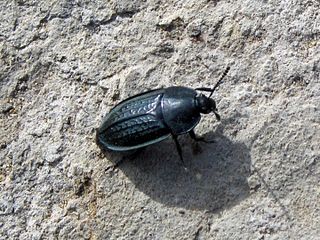
Silphidae is a family of beetles that are known commonly as large carrion beetles, carrion beetles or burying beetles. There are two subfamilies: Silphinae and Nicrophorinae. Members of Nicrophorinae are sometimes known as burying beetles or sexton beetles. The number of species is relatively small, at around two hundred. They are more diverse in the temperate region although a few tropical endemics are known. Both subfamilies feed on decaying organic matter such as dead animals. The subfamilies differ in which uses parental care and which types of carcasses they prefer. Silphidae are considered to be of importance to forensic entomologists because when they are found on a decaying body they are used to help estimate a post-mortem interval.

Histeridae is a family of beetles commonly known as clown beetles or hister beetles. This very diverse group of beetles contains 3,900 species found worldwide. They can be easily identified by their shortened elytra that leaves two of the seven tergites exposed, and their geniculate (elbowed) antennae with clubbed ends. These predatory feeders are most active at night and will fake death if they feel threatened. This family of beetles will occupy almost any kind of niche throughout the world. Hister beetles have proved useful during forensic investigations to help in time of death estimation. Also, certain species are used in the control of livestock pests that infest dung and to control houseflies. Because they are predacious and will even eat other hister beetles, they must be isolated when collected.

Nicrophorus americanus, also known as the American burying beetle or giant carrion beetle, is a critically endangered species of beetle endemic to North America. It belongs to the order Coleoptera and the family Silphidae. The carrion beetle in North America is carnivorous, feeds on carrion and requires carrion to breed. It is also a member of one of the few genera of beetle to exhibit parental care. The decline of the American burying beetle has been attributed to habitat loss, alteration, and degradation, and they now occur in less than 10% of their historic range.

Silphinae is a subfamily of carrion beetles. There are 113 extant species of this subfamily, in two tribe and in 14 genera. It contains the following tribes and genera:

Catops paramericanus is a species of small carrion beetle in the family Leiodidae. It is found in North America.

Aclypea opaca is a species of carrion beetle in the family Silphidae. It is found in Europe and Northern Asia and North America.

Aclypea is a genus of carrion beetles in the family Silphidae. There are 11 described species in Aclypea.

Thanatophilus lapponicus, the northern carrion beetle, is a species of carrion beetle in the family Silphidae. It is found in Europe and Northern Asia, Central America, and North America.

Thanatophilus is a genus of carrion beetles in the family Silphidae. There are about 12 described species in Thanatophilus.

Oiceoptoma inaequale, the ridged carrion beetle, is a species of carrion beetle in the family Silphidae. It is found in North America.
Heterosilpha is a genus of carrion beetles in the family Silphidae. There are at least two described species in Heterosilpha.

Heterosilpha ramosa, the garden carrion beetle, is a species of carrion beetle in the family Silphidae. It is found in Central America and North America.
Ipelates latus is a species of primitive carrion beetle in the family Agyrtidae. It is found in North America.
Ipelates is a genus of primitive carrion beetles in the family Agyrtidae. There are at least four described species in Ipelates.

Thanatophilus trituberculatus is a species of carrion beetle in the family Silphidae. It is found in North America and Europe.
Necrophilus pettiti, the small scavenger beetle, is a species of primitive carrion beetle in the family Agyrtidae. It is found in North America.

Necrodes surinamensis, the red-lined carrion beetle, is a species of carrion beetle in the family Silphidae. It is found in North America.

Necrodes is a genus of carrion beetles in the family Silphidae. There are at least four described species in Necrodes.
Platycholeus leptinoides is a species of small carrion beetle in the family Leiodidae. It is found in North America.
Silphini is a tribe of carrion beetles in the subfamily Silphinae. It contains the following genera:












